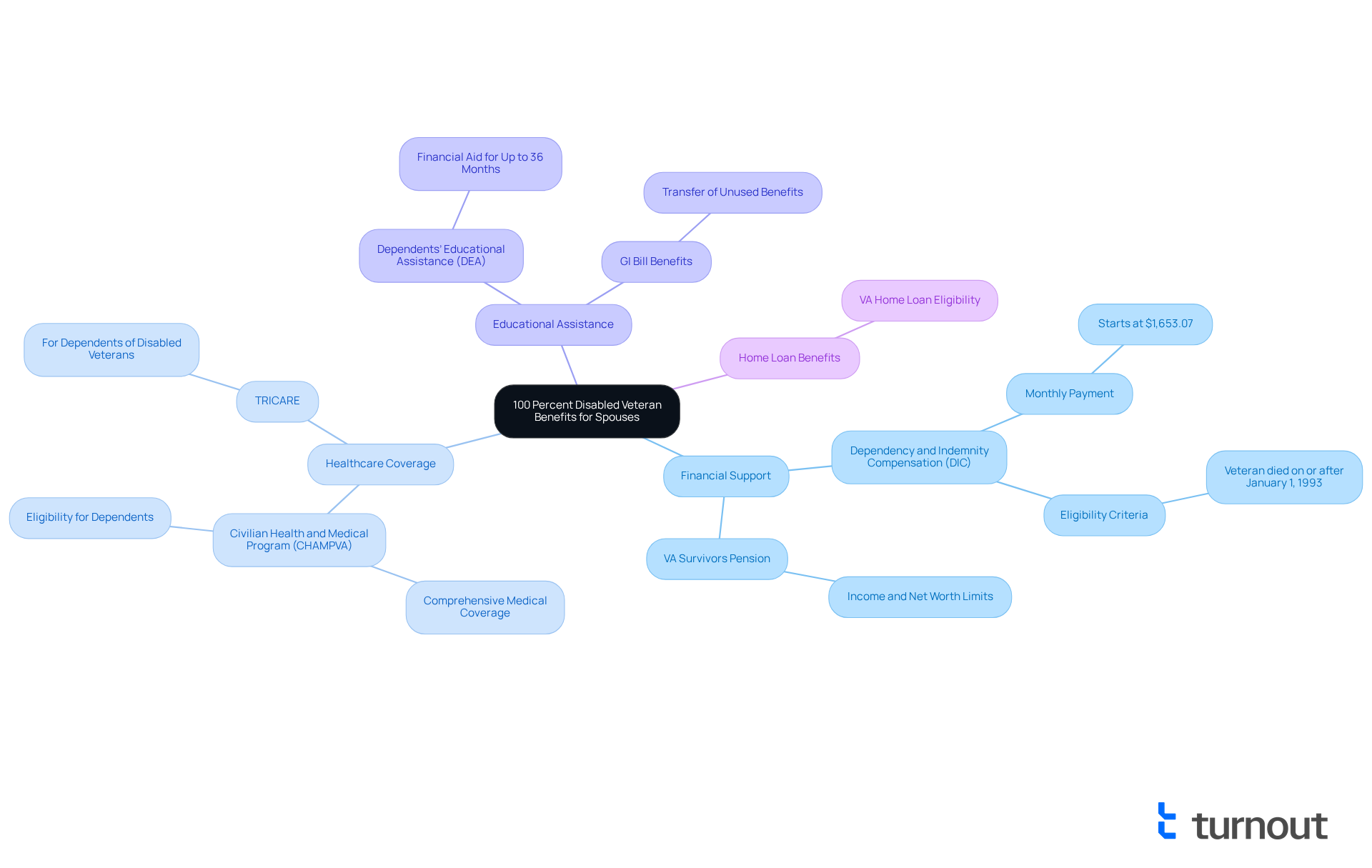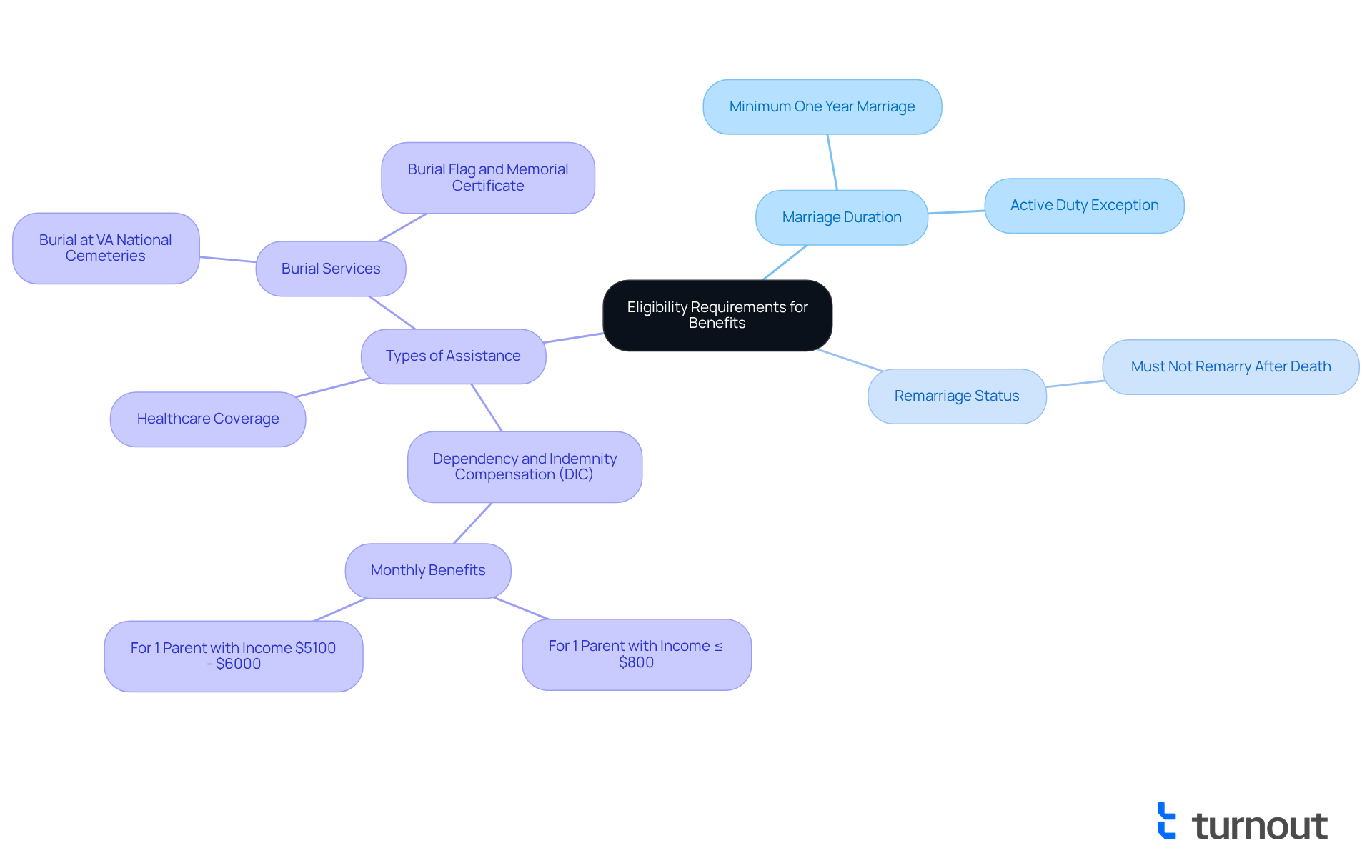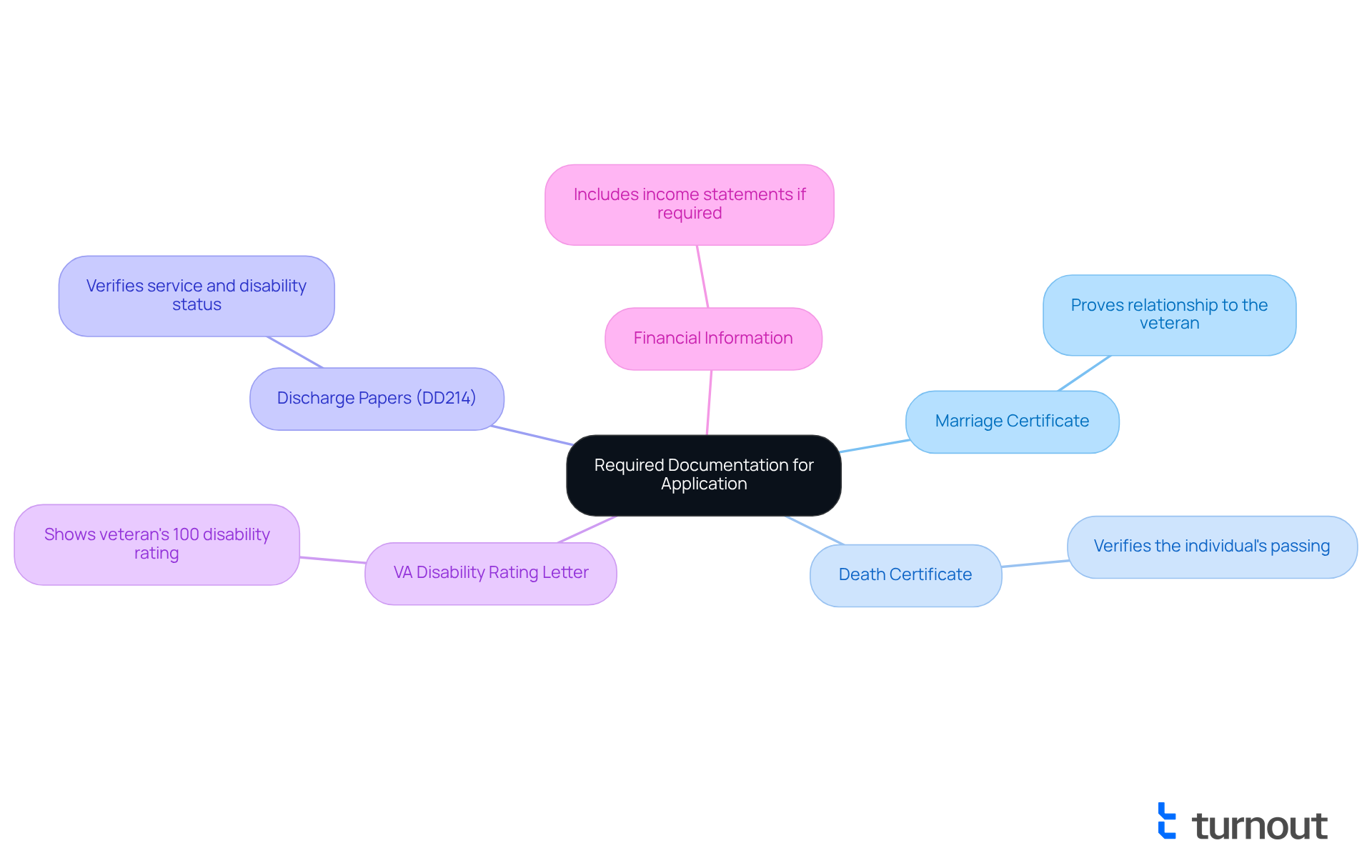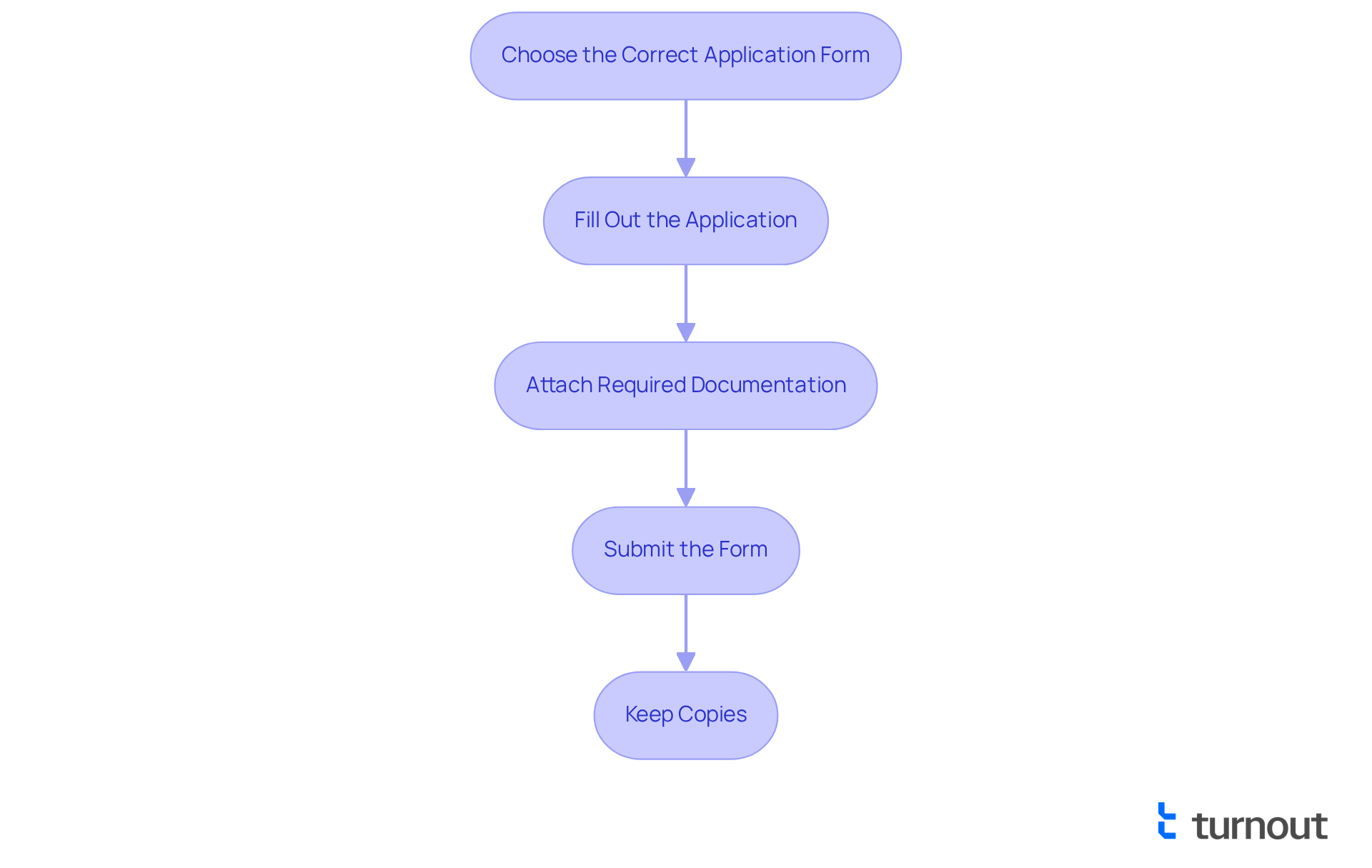Overview
This article provides a compassionate overview of the necessary steps for spouses of 100 percent disabled veterans to access their benefits after the veteran's passing. We understand that this can be a challenging time, and it's important to know that you're not alone in this journey. The process involves:
- Understanding eligibility
- Gathering the right documentation
- Completing the application
- Following up diligently
Navigating these steps thoughtfully is essential to secure vital benefits such as:
- Dependency and Indemnity Compensation (DIC)
- Healthcare coverage
- Educational assistance
We’re here to help you through this process, offering detailed guidance on required documents and application procedures. Remember, you deserve support during this time, and taking these steps can make a significant difference in your future.
Introduction
Navigating the aftermath of losing a spouse who served in the military can be an overwhelming experience. We understand that understanding the benefits available to surviving partners of 100 percent disabled veterans adds another layer of complexity. These benefits include:
- Financial support
- Healthcare coverage
- Educational assistance
All designed to provide essential resources during this challenging time. However, it's common to feel uncertain about eligibility or the application process, leading to confusion and frustration.
How can surviving spouses ensure they access the full range of benefits they are entitled to? What steps must they take to overcome potential obstacles? We're here to help you navigate this journey, so you don’t have to face it alone.
Understand 100 Percent Disabled Veteran Benefits for Spouses
After the loss of their spouse, partners of completely disabled service members face unique challenges, making it important to understand the 100 percent disabled veteran benefits for spouse after death that are available. One significant benefit is the Dependency and Indemnity Compensation (DIC), which provides a monthly tax-free payment to qualified partners. As of 2025, the DIC payment starts at $1,653.07 for those whose veteran partner died on or after January 1, 1993. This financial support can help ease the burden during such a difficult time.
In addition to DIC, surviving partners may also qualify for healthcare coverage through the Civilian Health and Medical Program of the Department of Veterans Affairs (CHAMPVA). This program offers comprehensive medical coverage, including hospital care, outpatient services, and prescription medications. It ensures that partners have access to essential healthcare without facing overwhelming costs.
Moreover, educational support is another vital resource. The Dependents’ Educational Assistance program provides financial aid for up to 36 months, empowering partners to pursue higher education or vocational training. This assistance can help them acquire valuable skills and improve their career prospects.
Additionally, surviving partners may qualify for home loan benefits, promoting home ownership and financial stability. Understanding these advantages is crucial for partners navigating the complexities of the VA system, particularly in relation to 100 percent disabled veteran benefits for spouse after death. Remember, you are not alone in this journey; we’re here to help you access the support you need during this challenging time.

Identify Eligibility Requirements for Benefits
To qualify for 100 percent disabled veteran benefits for spouse after death, specific eligibility criteria must be met. We understand that navigating these requirements can be overwhelming. Generally, you must have been married to the serviceman for at least one year prior to their death. However, if the service member died while on active duty, the duration of the marriage is not a factor. Furthermore, to preserve qualification for assistance like Dependency and Indemnity Compensation (DIC), you must not have remarried after the veteran's death.
Starting in 2025, it is essential to examine the particular criteria for each category of assistance, as they may vary. According to the Department of Veterans Affairs, surviving partners may receive various forms of assistance, including healthcare coverage and burial services, provided they meet these criteria. It's common to feel uncertain about these provisions, but recent updates suggest that a substantial percentage of partners successfully fulfill the eligibility criteria for DIC assistance. This highlights the importance of understanding your options.
For instance, partners of veterans can receive 100 percent disabled veteran benefits for spouse after death, enabling them to access DIC assistance, which provides essential financial support during difficult periods. We're here to help you simplify access to these advantages. Turnout offers tools and services that aid in navigating the application process. Trained non-legal advocates can assist with SSD claims, and IRS-licensed enrolled agents are available for tax relief.
It is important to note that Turnout is not a law firm and does not provide legal advice. We want to ensure that you have the guidance needed to secure the support you deserve. Remember, you are not alone in this journey.

Gather Required Documentation for Application
When applying for benefits, we understand that gathering the necessary documents can feel overwhelming. However, having the right paperwork in order is essential for ensuring a smooth process. Here are some key documents you will need:
- Marriage Certificate: This document proves your relationship to the veteran. Make sure it's prepared according to VA requirements to facilitate the approval process.
- Death Certificate: This is necessary to verify the individual's passing. Proper preparation is crucial for a successful application.
- Discharge Papers (DD214): These papers verify the individual's service and disability status.
- VA Disability Rating Letter: This letter shows the veteran's 100 percent disability rating.
- Financial Information: Include income statements if required for certain benefits.
Arranging these documents beforehand can greatly simplify the submission process and help prevent unnecessary delays. While the time needed to collect these documents can vary, being organized can significantly speed up your submission. Remember, successful requests for 100 percent disabled veteran benefits for spouse after death often depend on the thoroughness and precision of your submitted documentation.
It's common to feel anxious about the VA health care enrollment process, which typically takes about 35 minutes. This can serve as a helpful benchmark for applicants regarding the time needed for gathering documentation. We’re here to help you navigate this journey, and remember, you are not alone in this process. Providing the required documents is vital for positive results, as highlighted by case studies concerning military personnel's educational assistance.

Complete the Application Process for Benefits
Navigating the application process for benefits can feel overwhelming, but we're here to help. Follow these essential steps to ensure a smooth experience:
- Choose the Correct Application Form: For Dependency and Indemnity Compensation (DIC), it's important to use VA Form 21P-534EZ, specifically designed for this purpose.
- Fill Out the Application: Take your time to provide accurate information, ensuring all sections are fully completed. Double-checking for any errors or omissions is crucial, as it can prevent delays in processing.
- Attach Required Documentation: Gather all necessary documents, such as the veteran's service records and marriage certificate, to support your request. This will strengthen your application.
- Submit the Form: You can submit your application online through the VA website, by mail, or in person at a local VA regional office—choose the option that feels best for you.
- Keep Copies: Always retain duplicates of your submission and all provided documents for your records. This will be beneficial for any future inquiries or follow-ups regarding your submission status.
Remember, you are not alone in this journey, and taking these steps can make a difference.

Follow Up and Troubleshoot After Application Submission
After sending your request, we understand that following up is essential to ensure it is being handled efficiently. Here’s how to navigate this important phase:
- Track Your Submission: Utilize the VA's online tracking system or call the VA benefits hotline to check the status of your submission. This proactive approach can help you stay informed and feel more in control.
- Be Prepared for Additional Requests: It’s common for the VA to occasionally request further information or documentation. Responding swiftly to these requests is crucial to prevent unnecessary delays in processing your submission.
- Contact a Veterans Service Organization (VSO): If you encounter challenges or require assistance, reaching out to a VSO can be invaluable. They provide support during the submission process, helping you navigate any complexities with care.
- Keep Records: Maintain detailed documentation of all communications with the VA, including dates, times, and the names of representatives you speak with. This record-keeping can be instrumental if you need to escalate any issues or clarify misunderstandings.
Veterans' advocates emphasize the importance of tracking applications closely. The average time taken for the VA to process additional information requests can vary significantly. For instance, some veterans have reported waiting several weeks for a response, while others have experienced delays of several months. By remaining involved and orderly, you can assist in ensuring a more seamless experience in obtaining the benefits you deserve.
As one advocate noted, "Staying proactive in your application process can make all the difference in the outcome." Additionally, there are numerous cases where diligent tracking has led to successful resolutions, such as a veteran who received retroactive benefits after persistent follow-ups, enabling them to address urgent financial needs. Remember, you are not alone in this journey; we’re here to help you every step of the way.
![]()
Conclusion
Understanding and accessing 100 percent disabled veteran benefits for spouses after the death of a veteran can be a challenging yet essential journey. We recognize that this process may feel overwhelming, but it is crucial to know that there are resources available to support you. These include:
- Dependency and Indemnity Compensation (DIC)
- Healthcare coverage
- Educational support
- Home loan benefits
These resources can provide vital assistance during this difficult time. Acknowledging these benefits is the first step toward securing the necessary support for surviving partners.
It's important to understand the eligibility requirements, gather the necessary documentation, and navigate the application process. For instance, ensuring that the marriage duration meets the criteria and collecting vital documents like the marriage and death certificates are crucial steps for a successful application. It’s common to feel uncertain, but following up on submissions and being prepared for potential requests from the VA can significantly influence the outcome and timeliness of receiving benefits.
Accessing 100 percent disabled veteran benefits for spouses after death is not just about financial support; it is about honoring the sacrifices made by veterans and ensuring their partners receive the help they deserve. By staying informed, organized, and proactive throughout the process, surviving spouses can navigate the complexities of the VA system more effectively. Remember, you are not alone in this journey. Seeking assistance and utilizing available resources is vital to securing the benefits that can provide stability and peace of mind during challenging times.
Frequently Asked Questions
What are the main benefits available to spouses of 100 percent disabled veterans after their death?
The main benefits include Dependency and Indemnity Compensation (DIC), healthcare coverage through the Civilian Health and Medical Program of the Department of Veterans Affairs (CHAMPVA), educational support through the Dependents’ Educational Assistance program, and home loan benefits.
What is Dependency and Indemnity Compensation (DIC)?
DIC is a monthly tax-free payment provided to qualified partners of completely disabled service members, starting at $1,653.07 for those whose veteran partner died on or after January 1, 1993.
What healthcare benefits are available for surviving spouses?
Surviving partners may qualify for healthcare coverage through CHAMPVA, which offers comprehensive medical coverage, including hospital care, outpatient services, and prescription medications.
How does the Dependents’ Educational Assistance program support surviving spouses?
This program provides financial aid for up to 36 months, allowing partners to pursue higher education or vocational training, thereby improving their career prospects.
What are the eligibility requirements for receiving benefits as a surviving spouse?
Generally, you must have been married to the serviceman for at least one year prior to their death, unless the service member died while on active duty. Additionally, you must not have remarried after the veteran's death to preserve qualification for benefits like DIC.
How can I get assistance with the application process for these benefits?
Organizations like Turnout offer tools and services to help navigate the application process, including assistance from trained non-legal advocates for SSD claims and IRS-licensed enrolled agents for tax relief.
Is Turnout a legal firm?
No, Turnout is not a law firm and does not provide legal advice, but it offers guidance to help secure the support you need.




